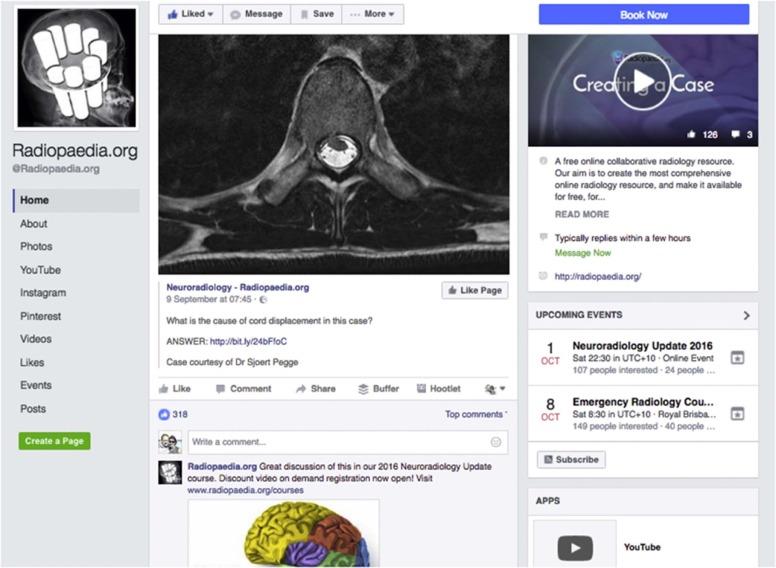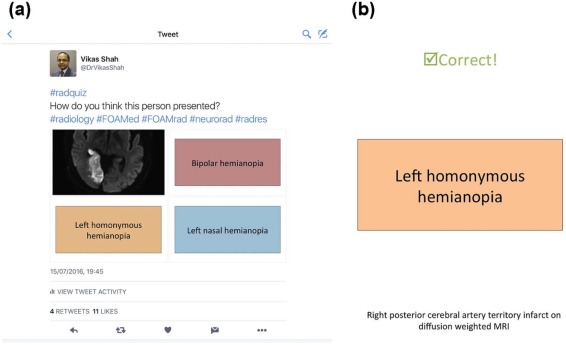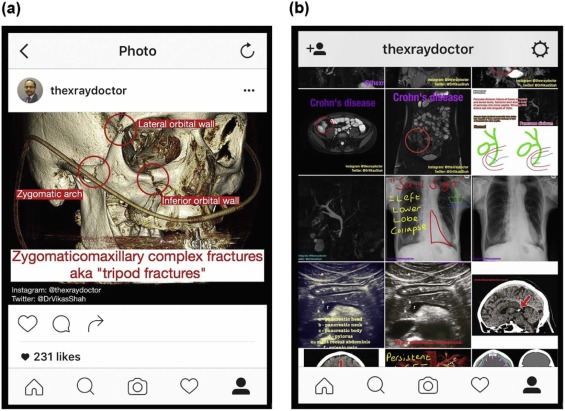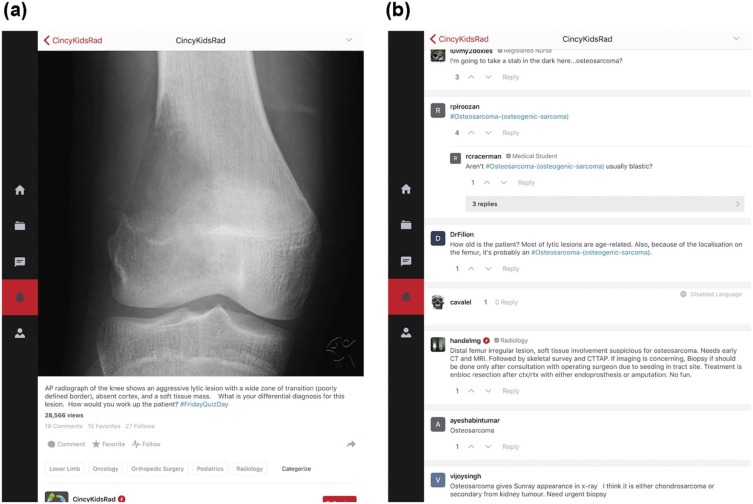In this article, we describe how social media can supplement traditional education, articulate the advantages and disadvantages of various social media platforms for both teachers and learners, discuss best practices to maintain confidentiality of protected health information, and provide tips for implementing social media-based teaching into the training curriculum.
Introduction
Social media are online tools that allow individuals and groups to create content, share information, and connect with one another in virtual communities. The millennial generation, roughly those born between 1980 and 2000, have an almost universal smartphone ownership and usage. Consequently, millenials already spend a great deal of time using social media: 96% of students with Internet access use social media generally and 60% use social media specifically to discuss educational topics . In medicine, one study found that 94% of medical students, 79% of medical residents, and 42% of practicing physicians use social media . For learning, this generation favors technology over traditional media such as textbooks and journals, has become accustomed to instant access to information, and expects to be entertained even while learning. These factors make social media an ideal educational tool.
With social media you can reach one or more of multiple audiences: radiology residents and fellows, medical students, other health-care providers, and even patients and their families. Social media require minimal technological resources but do require a time commitment. Content consumption and creation can happen any time, in any place, and by any user. Once created, social media content can be reposted on multiple platforms to reach a larger target audience.
Social Media Terminology
Before we delve further into the use of social media for radiology education, it is important to review and understand social media terminology ( Table 1 ).
TABLE 1
Social Media Terminology
Term Definition Fans or followers People who subscribe to your content Views Number of people who have viewed a post Likes or favorites A connection to a post, greater level of interest than a view Share or retweet Repost of content thought to be of interest to a user’s own fans or followers, greater interest than like Reach Number of people who may have potentially seen a page or a post; includes fans or followers of shared content Engagement Collective number of views, likes, and shares Hashtag # followed by a single word or phrase, used to search and filter content on a particular topic #FOAMRad Free open access medical education, radiology
Social Media Platforms for Education
Social media platforms have a global reach and massive user base. At the time of this writing, Facebook (Facebook, Menlo Park, CA) has the largest share of the market with over 1.5 billion active users worldwide. Other popular media such as Instagram (Facebook, Menlo Park, CA) and Twitter (Twitter, San Francisco, CA) have 400 million and 320 million active users, respectively .
Get Radiology Tree app to read full this article<
Get Radiology Tree app to read full this article<
Get Radiology Tree app to read full this article<
Get Radiology Tree app to read full this article<
Get Radiology Tree app to read full this article<
Get Radiology Tree app to read full this article<
Get Radiology Tree app to read full this article<
Get Radiology Tree app to read full this article<
Get Radiology Tree app to read full this article<
Figure 1
Get Radiology Tree app to read full this article<
Get Radiology Tree app to read full this article<
YouTube
Get Radiology Tree app to read full this article<
Blogs
Get Radiology Tree app to read full this article<
#FOAMRad
Get Radiology Tree app to read full this article<
Get Radiology Tree app to read full this article<
Comparison Between Platforms
Get Radiology Tree app to read full this article<
TABLE 2
Comparison of Social Media Platforms
Facebook Twitter Instagram Figure 1 YouTube Character count in captions 63,000 140 2,200 599 5,000 Maximum number of images Unlimited Four per post One per post Five per post Video-only platform Maximum length of video 45 min 2 min and 20 s 1 min Video not supported, scrollable stacks of up to 20-MB file size can be uploaded >1 h Format of responses and comments Nested comments Replies and quote retweets Un-nested comments Nested comments Un-nested comments Image manipulation Inbuilt tools to enhance images, no marking up tools Inbuilt tools to enhance images, no marking up tools Inbuilt tools to apply image filters, no marking up tools Inbuilt tools to anonymize and mark up with arrows Inbuilt tools to enhance videos, no marking up tools Clickable rich links in captions supported? Yes Yes No No Yes
Get Radiology Tree app to read full this article<
Protecting Patient Information
Get Radiology Tree app to read full this article<
Etiquette and Professional Behavior on Social Media
Get Radiology Tree app to read full this article<
Get Radiology Tree app to read full this article<
Get Radiology Tree app to read full this article<
TABLE 3
Guidelines to Maintain Etiquette and Professional Behavior on Social Media
Write only that which one would say out loud in a room full of friends and strangers. Remember that you are representing not only yourself but also your profession. Communications on social media are in the public domain and are subject to the same laws and rules as other means of communication such as public lectures and e-mail. If using an account for both personal and professional use, consider carefully what is said in the personal domain. Be polite and respectful when others may disagree with your point of view. Stick to stating scientifically and evidence-backed facts. Patients may use social media to glean information about their own medical conditions; avoid dispensing medical advice to patients over social media.
Get Radiology Tree app to read full this article<
Disadvantages of Social Media in Education
Get Radiology Tree app to read full this article<
Get Radiology Tree app to read full this article<
Tips for Incorporating Social Media in Education
Get Radiology Tree app to read full this article<
TABLE 4
Tips for Incorporating Social Media in Education
Content Platform Use deidentified images and approximate ages. Ensure the profile used is “professional.” Avoid posting “sensational” cases. Start with one or two platforms then build to cross-posting on multiple platforms as you grow your audience and content. Store images securely on password-protected drives. Use appropriate hashtags to allow content to be discovered. Seek patient consent if posting a rare case. Engage with followers to foster educational relationships. It takes time to build a following. Do not get obsessed with numbers!
Get Radiology Tree app to read full this article<
Get Radiology Tree app to read full this article<
Get Radiology Tree app to read full this article<
Conclusion
Get Radiology Tree app to read full this article<
Acknowledgments
Get Radiology Tree app to read full this article<
References
1. Bennett S.: How Is Social Media Used in Schools? Statistics, Facts & Figures Social Times: Social Times. Available at: http://www.adweek.com/socialtimes/schools-social-media-stats/488104/ Accessed June 21, 2016
2. Bosslet G.T., Torke A.M., Hickman S.E., et. al.: The patient–doctor relationship and online social networks: results of a national survey. J Gen Intern Med 2011; 26: pp. 1168-1174.
3. Chaffey D.: Global social media research summary 2016. SmartInsights; Available at: http://www.smartinsights.com/social-media-marketing/social-media-strategy/new-global-social-media-research/ Accessed August 21, 2016
4. Buffer : Buffer. Available at: https://buffer.com/ Accessed September 5, 2016
5. Hootsuite : Hootsuite. Available at: https://hootsuite.com/ Accessed September 5, 2016
6. Duggan M., Ellison N.B., Lampe C., et. al.: Social Media Update 2014. Pew Research Center; [updated 1/9/2015]; Available at: http://www.pewinternet.org/2015/01/09/social-media-update-2014/ Accessed September 5, 2016
7. Pander T., Pinilla S., Dimitriadis K., et. al.: The use of Facebook in medical education—a literature review. GMS Z Med Ausbild 2014; 31: Doc33
8. Oremus W.: Who Controls Your Facebook Feed. Slate; [updated 1/3/2016]; Available at: http://www.slate.com/articles/technology/cover_story/2016/01/how_facebook_s_news_feed_algorithm_works.html Accessed September 2, 2016
9. Sherman T.: Coming soon: express even more in 140 characters. Twitter; [updated May 24, 2016]; Available at: https://blog.twitter.com/express-even-more-in-140-characters Accessed September 2, 2016
10. Silcoff S.: “Instagram for doctors” Figure 1 reaches a million users, adds messaging tool The Globe and Mail. [updated 4/14/2016]; Available at: http://www.theglobeandmail.com/report-on-business/small-business/startups/instagram-for-doctors-adds-messaging-tool-after-reaching-a-million-users/article29589235/ Accessed September 5, 2016
11. Cadogan M.: Creating the FOAMed network. n.d.; Available at: http://lifeinthefastlane.com/creating-the-foam-network/ Accessed September 2, 2016
12. Council G.M.: Doctors’ use of social media. General Medical Council; [updated 2013]; Available at: http://www.gmc-uk.org/guidance/ethical_guidance/21186.asp Accessed September 2, 2016
13. Association B.M.: Social media use: practical and ethical guidance for doctors and medical students. [updated 8/22/2016]; Available at: https://www.bma.org.uk/advice/employment/ethics/ethics-a-to-z Accessed September 5, 2016
14. Aase L.: New #SocialAtMayo video educates Mayo Clinic employees on social media guidelines. Mayo Clinic Social Media Network; Available at: https://socialmedia.mayoclinic.org/discussion/new-socialatmayo-video-will-educate-mayo-clinic-employees-on-social-media-guidelines Accessed September 5, 2016
15. Kind T.: Professional guidelines for social media use: a starting point. AMA J Ethics 2015; 17: pp. 441-447.
16. Phonto : Phonto. Available at: http://www.phon.to/ Accessed September 2, 2016
17. Vont : Vont. Available at: http://www.phon.to/vont Accessed September 2, 2016
18. Facebook : Dubme. Available at: https://www.facebook.com/dubmeapp/ Accessed September 2, 2016



